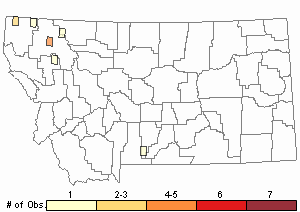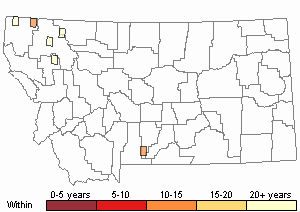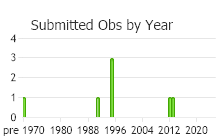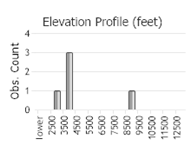View in other NatureServe Network Field Guides
NatureServe
Montana
Utah
Wyoming
Idaho
Wisconsin
British Columbia
South Carolina
Yukon
California
New York
A Rhizomnium Moss - Rhizomnium pseudopunctatum
General Description
Plants: Acrocarpous, green (Lawton 1971) or deep green, growing in open clumps of upright shoots (Crum and Anderson et al. 1981). Stems turning deep red to russet with time, 2-9 cm in height; rhizoids brown (FNA 2014), matted and woolly, particularly proximally (Lawton 1971), and micronemata present, although possibly not on young growth (FNA 2014).
Leaves: Somewhat twisted, curved or bent, and loosely upright to spreading to about 45 degrees when dry (Crum and Anderson et al. 1981), typically flat or occasionally slightly wavy (FNA 2014) and spreading when damp (Crum and Anderson et al. 1981), 3-7 mm in length, widest in the middle, widely obovate, or sometimes nearly circular, ending in a curved or sometimes obtuse, shallowly-notched, or squared-off leaf tip, seldom with a short apiculus; margins flat, smooth, occasionally somewhat red; costa not approaching the leaf tip closely to seldom reaching or nearly reaching it, occasionally forking above, the upper part of the dorsal face smooth (FNA 2014).
Leaf Cells: Margins 1 cell-layer thick (FNA 2014) above, 2 or 3 layers in thickness below (Lawton 1971); marginal cells distinct (FNA 2014), smooth (Crum and Anderson et al. 1981), long and thin or somewhat rectangular to diamond-shaped, in 1-3 series; medial laminal cells somewhat long, faintly porose, with slightly thickened wall angles (FNA 2014); distal cells somewhat long and 6-sided to oblong, in diagonal rows, the walls somewhat thick and porose (Crum and Anderson et al. 1981); alar cells not distinct from adjacent cells (FNA 2014).
Phenology
Fruit ripens in spring and through summer (FNA 2014).
Diagnostic Characteristics
A key characteristic for distinguishing Rhizomnium species is the presence or absence of micronemata on older stems. New growth often lacks micronemata, so checking and comparing mature stems, which may be covered with litter, is necessary (FNA 2014).
Other than R. pseudopunctatum, no other species in the genus is synoicous in North America and Greenland (FNA 2014).
R. pseudopunctatum may be mistaken for small Rhizomnium magnifolium plants. R. magnifolium, however, has long and thin marginal cells arranged in 2 layers above rather than marginal cells shorter, typically diamond-shaped to rectangular, and always arranged in 1 layer above as in R. magnifolium (FNA 2014).
Range Comments
North American Range
AK to NT, BC to NL and NB, OR and CA, MT s to CO, also MI, NY, and ME (FNA 2014). Known in Montana from Fergus, Flathead, Gallatin, Glacier, Lewis and Clark, and Sweet Grass Counties (Elliott and Pipp 2016).
Observations in Montana Natural Heritage Program Database
Number of Observations: 12
(Click on the following maps and charts to see full sized version)
Map Help and Descriptions
Relative Density

Recency



 (Observations spanning multiple months or years are excluded from time charts)
(Observations spanning multiple months or years are excluded from time charts)
Habitat
Damp or wet soil, humus and peat, near seeps, high-nutrient and calcareous wetlands. Occurring from lowlands to medium altitudes (FNA 2014) of around 4920 feet or more (Lawton 1971).
Reproductive Characteristics
Archegonia and antheridia associating in the same bract cluster. Seta solitary, 13-50 mm tall. Capsule 1.5-2.5 mm in length, egg-shaped to nearly globose (FNA 2014), light brown, both the short neck and the opening more deeply colored; stomata occurring in the neck, sunken (Crum & Anderson et al. 1981); exostome teeth 16, deep brown (FNA 2014), with striations and papillae above, and thickly papillose below; endostome cilia in 3s (Crum and Anderson et al. 1981). Calyptra draped like a monk’s hood (FNA 2014).
Stewardship Responsibility
References
- Literature Cited AboveLegend:
 View Online Publication
View Online Publication Crum, H.A. and L.E. Anderson. 1981. Mosses of Eastern North America. 2 volumes. Columbia University Press, New York. 1328 pp.
Crum, H.A. and L.E. Anderson. 1981. Mosses of Eastern North America. 2 volumes. Columbia University Press, New York. 1328 pp. Elliott, J.C. and A.K. Pipp. 2018. A Checklist of Montana Mosses (1880-2018). Updated 3 January, 2020. Montana Natural Heritage Program, Helena, Montana. 73 pp.
Elliott, J.C. and A.K. Pipp. 2018. A Checklist of Montana Mosses (1880-2018). Updated 3 January, 2020. Montana Natural Heritage Program, Helena, Montana. 73 pp. Flora of North America Editorial Committee, eds. 2014. Flora of North America North of Mexico. Volume 28. Bryophytes: Mosses, Part 2. Oxford University Press, Inc., NY. xxi + 702 pp.
Flora of North America Editorial Committee, eds. 2014. Flora of North America North of Mexico. Volume 28. Bryophytes: Mosses, Part 2. Oxford University Press, Inc., NY. xxi + 702 pp. Lawton, E. 1971. Moss Flora of the Pacific Northwest. Hattori Botanical Laboratory. Japan: Yamabuki-cho, Shinjuku-ku, Tokyo. 362 pages plus appendices.
Lawton, E. 1971. Moss Flora of the Pacific Northwest. Hattori Botanical Laboratory. Japan: Yamabuki-cho, Shinjuku-ku, Tokyo. 362 pages plus appendices.
- Additional ReferencesLegend:
 View Online Publication
View Online Publication
Do you know of a citation we're missing? Elliot, J. C. 1993. Second checklist of Montana mosses. Unpublished report. U.S. Forest Service, Region 1. Missoula, MT. 45 pp.
Elliot, J. C. 1993. Second checklist of Montana mosses. Unpublished report. U.S. Forest Service, Region 1. Missoula, MT. 45 pp. Lawton, E. 1971. Keys for the Identification of the Mosses on the Pacific Northwest. Reprinted from 'Moss Flora of the Pacific Northwest'. Published as Supplement No. 2 of the Journal of the Hattori Botanical Laboratory. Nichinan, Miyazaki, Japan. 66 pp.
Lawton, E. 1971. Keys for the Identification of the Mosses on the Pacific Northwest. Reprinted from 'Moss Flora of the Pacific Northwest'. Published as Supplement No. 2 of the Journal of the Hattori Botanical Laboratory. Nichinan, Miyazaki, Japan. 66 pp. Malcolm, B., N. Malcolm, J. Shevock, and D. Norris. 2009. California Mosses. Nelson, New Zealand: Micro-Optics Press. 430 pp.
Malcolm, B., N. Malcolm, J. Shevock, and D. Norris. 2009. California Mosses. Nelson, New Zealand: Micro-Optics Press. 430 pp. Smith, A.J.E. 1980. The Moss Flora of Britain and Ireland. Cambridge University Press, Cambridge. 705 pp.
Smith, A.J.E. 1980. The Moss Flora of Britain and Ireland. Cambridge University Press, Cambridge. 705 pp.
- Web Search Engines for Articles on "A Rhizomnium Moss"





